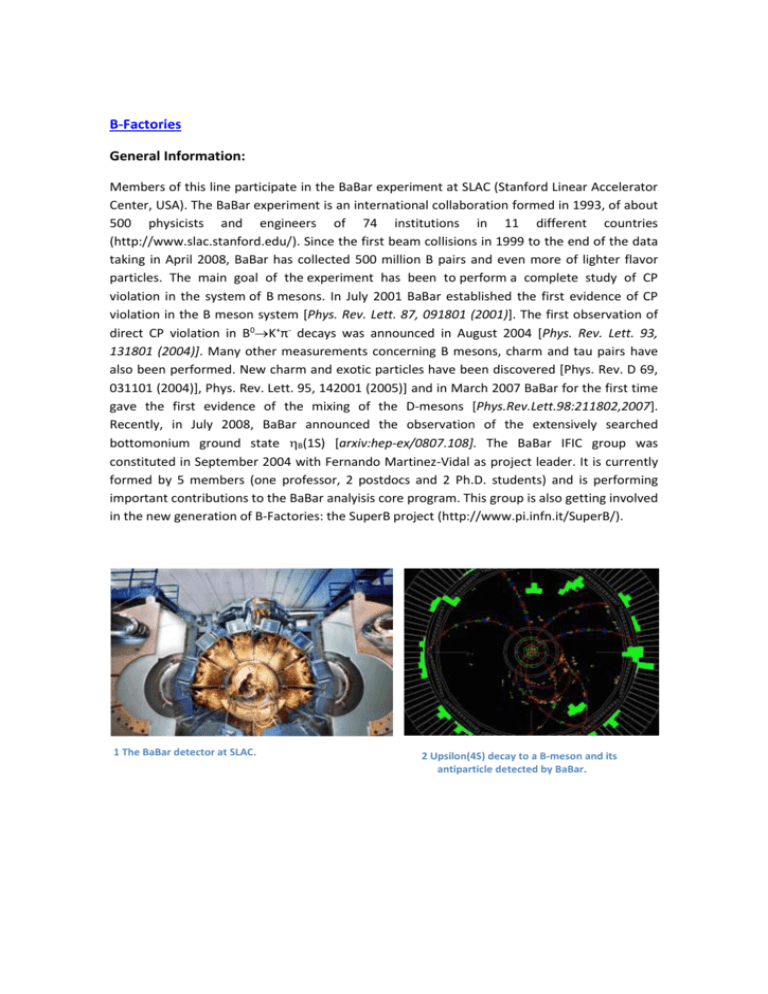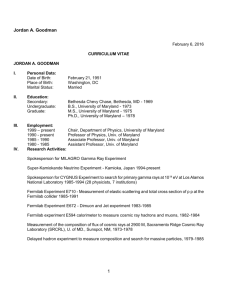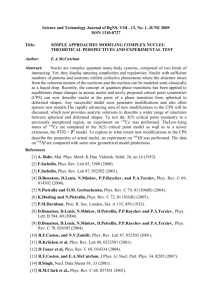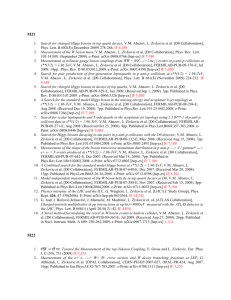B-Factories General Information: Members of this line participate in
advertisement

B-Factories General Information: Members of this line participate in the BaBar experiment at SLAC (Stanford Linear Accelerator Center, USA). The BaBar experiment is an international collaboration formed in 1993, of about 500 physicists and engineers of 74 institutions in 11 different countries (http://www.slac.stanford.edu/). Since the first beam collisions in 1999 to the end of the data taking in April 2008, BaBar has collected 500 million B pairs and even more of lighter flavor particles. The main goal of the experiment has been to perform a complete study of CP violation in the system of B mesons. In July 2001 BaBar established the first evidence of CP violation in the B meson system [Phys. Rev. Lett. 87, 091801 (2001)]. The first observation of direct CP violation in B0K+π- decays was announced in August 2004 [Phys. Rev. Lett. 93, 131801 (2004)]. Many other measurements concerning B mesons, charm and tau pairs have also been performed. New charm and exotic particles have been discovered [Phys. Rev. D 69, 031101 (2004)], Phys. Rev. Lett. 95, 142001 (2005)] and in March 2007 BaBar for the first time gave the first evidence of the mixing of the D-mesons [Phys.Rev.Lett.98:211802,2007]. Recently, in July 2008, BaBar announced the observation of the extensively searched bottomonium ground state B(1S) [arxiv:hep-ex/0807.108]. The BaBar IFIC group was constituted in September 2004 with Fernando Martinez-Vidal as project leader. It is currently formed by 5 members (one professor, 2 postdocs and 2 Ph.D. students) and is performing important contributions to the BaBar analyisis core program. This group is also getting involved in the new generation of B-Factories: the SuperB project (http://www.pi.infn.it/SuperB/). 1 The BaBar detector at SLAC. 2 Upsilon(4S) decay to a B-meson and its antiparticle detected by BaBar. Present situation: - Personal: Fernando Martínez-Vidal Maria Aranzazu Oyanguren Campos Virginia Azzolini Diego Alejandro Milanés (PhD) Neus Lopez-March (PhD) - Financiación: Publicaciones: Transferencia de conocimiento: Formación: Divulgación: Internalización: Otros Datos: Análisis crítico, DAFO y AR - Análisis DAFO: [SWOT= Strengths, Weaknesses, Opportunities and Threats] (Strengths) One of the strengths of this line is the mastery of performing data analysis in different experimental environments, such as hadron and electron colliders operating at several energies. Members of the line working in the DELPHI, BaBar and CDF collaborations have presented precise results of great impact in the community (see list of publications). In the last five years important measurements as the J/psi meson and bhadron production cross sections [Phys.Rev.D71:032001,2005] (274 cites), the ttbar production cross section [Phys.Rev.D71:052003,2005] (127 cites) the observation of B oscillations by CDF [Phys.Rev.Lett.97:242003,2006] (215), and the observation of the new massive particle Y(4260) [Phys.Rev.Lett.95:142001, 2005.] (180 cites) by BaBar, the search for lepton flavor violation [Phys.Rev.Lett.95:041802,2005] at BaBar (102 cites) or the evidence of the D mixing [Phys.Rev.Lett.98:211802,2007] (94 cites) manifest the significant impact of this line activity in the scientific community. This expertise is crucial for the analysis performed with the data acquired by the new detectors ( @ LHC, SuperB and ILC). The line has an important background on B-Physics. Measurements at DELPHI of mb [Eur.Phys.J.C55:525-538,2008, Eur.Phys.J.C46:569-583,2006, and references therein], Rb [Eur.Phys.J.C10:415-442,1999 and references therein] and |Vcb| [Eur.Phys.J.C33:213-232,2004., Eur.Phys.J.C45:35-59,2006 and references therein], and the large contribution to BaBar measurements (studies of CP, T and CPT violation in B decays [Phys.Rev.Lett.92,181801,2004, Phys.Rev.D70,012007,2004], the measurement of the CKM angle [Phys.Rev.Lett.95,121802,2005, Phys.Rev.Lett.98:211802,2007] and |Vub| [Phys Rev. D.72, 051102,2005, Phys. Rev. Lett. 95, 111801,2005]…) are proof of the competence in this subject, and an evident strength for a strong activity in the future B-Factory facilities. Additionally, the line has expertise on vertex detectors: it is involved in RD, construction and particle reconstruction (see Carlos part). In particular the BaBar-IFIC group has taken responsibilities of the Silicon Vertex Detector (SVT) at SLAC, in commissioning tasks and contributing to the improvement of the pattern recognition for track reconstruction. The competence of the line in this subject is decisive for a significant participation in the construction of the next generation of B-Factories (SuperB and SuperBelle). An important strength of the line comes from the increasing interaction and common scientific interests with the IFIC theoretical lines 6 and 7 (High Energy Physic Phenomenology and QCD and Strong Interactions). Common publications as arXiv:0709.0451 [hep-ex] is an example of this strength. The line has established strong and solid cooperation with different groups in several countries which are involved in the same experiments. It is also important to note the local participation of the IFIC members at the experiments (detector commissioning at CERN and at SLAC, staff people placed at CERN, etc…). (Weakness) The main weakness of the line is at present the poor approach by CSIC researchers to university students and the lack of initiatives to interact with them. It becomes necessary then to drive new schemes to present in the university the work of the different research groups involved in the line. The consequent threat following this is a present lack of new phD students for the incoming period. (Oportunities) The line has important opportunities in the next years in many aspects. The LHC has just started to take data promising new phenomena to be discovered. The BaBar and CDF experiments are in the ultimate period of data taking and analysis with the full statistics which can provide new and unexpected results. In particular, BaBar has collected a total of 531 fb-1. Measurements of the CKM angle and the D mixing parameter performed with the full statistics are expected to reach precisions of 15 and less than 0.3% respectively. On the other hand, a new generation of accelerators and detectors are starting to be built. The line is involved in the ILC, SuperB Factories and SuperLHC international Collaborations which are expected to have a large activity in the forthcoming years. Concerning B-Factories, a new project for the construction of a Super Flavour Factory SuperB has been developed [SuperB CDR, arXiv:0709.0451 [hep-ex]]. This new facility will be decisive for the search and the study of New Physics beyond the Standard Model. Any new physics model established at the energy scale of the LHC in the next years to solve the hierarchy problem of interactions includes new flavoured particles. Since those new particles must couple to the Standard Model particles, the New Physics cannot be flavour blind, and flavour observables must be affected. It is also entirely possible that the masses of the new particles may be out of the reach of the LHC. In this case only a high luminosity flavour factory would see the effects in flavour observables. The SuperB factory, with an antisymmetric e+-e- accelerator of polarized beams operating at the energy of the (4S) (with the possibility of operating at smaller energies), will reach an unprecedented integrated luminosity of 75 ab-1 in 5 years of operation. The physics program with this integrated luminosity is huge and complementary to any LHC result. Key measurements are related to observables which are exactly predicted by the Standard Model or have a very small uncertainty since they will provide a clear evidence of New Physics: flavor-violating decays, direct CP asymmetries in , in decays and in some non-leptonic D decays, CP violation in neutral charm meson mixing, lepton universality violating B and decays, etc… Any small deviation from the Standard Model will be a measurement of New Physics. Many other observables will reach an unprecedented precision in the flavor sector (CKM matrix elements, angles and sides of the Unitary Triangle, mixing parameters in charm decays, magnetic dipole moment…) [arXiv:0802.3201 [hep-ph]] in addition to many other possible measurements coming from the LHC discoveries. (threats) The main threat for this line in the incoming years is the potential lack of manpower (temporal and permanent). Since the line is involved in several running and in construction experiments, and has a strong program in detector R+D, it is difficult to expect other latent important threat. One unlikely possibility would be caused by the non discovery at LHC of any new particle. Even in this case, the 2010-1013 years will be an intensive period of searches at LHC, at the same time that a new SuperB machine, capable to observe heavier new particles, is being built. - Análisis relacional: Centros Colaboradores: 1) Institute: INFN SEZIONE DI PISA Institution: INFN Project leaders: Marcello Giorgi (Marcello.Giorgi@pi.infn.it), Alberto Lusiani (Alberto.Lusiani@pi.infn.it) Address: Istituto Nazionale di Fisica Nucleare Largo Pontecorvo, 3 56127 Pisa, Italy Web: http://www.pi.infn.it/ 2) Institute: LAL, ORSAY Institution: IN2P3-CNRS et Universite Paris-Sud 11 Project leader: Achille Stocchi (stocchi@lal.in2p3.fr) Address: Laboratoire de l'Accelerateur Lineaire Centre Scientifique d'Orsay, B.P. 34 91898 Orsay Cedex, France Web: http://www.lal.in2p3.fr/ Common publications: 1) Evidence for D0-anti-D0 Mixing. By BABAR Collaboration (B. Aubert et al.). SLAC-PUB-12385, BABAR-PUB-07-019, Mar 2007. 7pp. Published in Phys.Rev.Lett.98:211802,2007. e-Print: hep-ex/0703020 (cites: 94) 2) Improved measurement of the CKM angle gamma in B-+ ---> D(*) K(*)-+ decays with a Dalitz plot analysis of D decays to K0(S) pi+ pi- and K0(S) K+ K-. By BABAR Collaboration (B. Aubert et al.). SLAC-PUB-13209, BABAR-PUB-08-006, Apr 2008. 22pp. Published in Phys.Rev.D78:034023,2008. e-Print: arXiv:0804.2089 [hep-ex] (cites: 4) 3) Measurement of gamma in B-+ --> D(*) K-+ decays with a Dalitz analysis of D ---> K0(s) pipi+. By BABAR Collaboration (B. Aubert et al.). SLAC-PUB-11127, Apr 2005. 7pp. Published in Phys.Rev.Lett.95:121802,2005. e-Print: hep-ex/0504039 (cites: 67) 4) Measurement of the hadronic form-factor in D0 ---> K- e+ nu(e) . By BABAR Collaboration (B. Aubert et al.). SLAC-PUB-12417, BABAR-PUB-07-015, Apr 2007. 21pp. Presented at 42nd Rencontres de Moriond on QCD and Hadronic Interactions, La Thuile, Italy, 17-24 Mar 2007. Published in Phys.Rev.D76:052005,2007. e-Print: hep-ex/0607077, arXiv:0704.0020 [hep-ex] (cites: 18) 5) Measurements of Partial Branching Fractions for anti-B ---> X(u) l anti-nu and Determination of |V(ub)|. By BABAR Collaboration (B. Aubert et al.). BABAR-PUB-07-051, SLAC-PUB-12713, Aug 2007. 7pp. Presented at 23rd International Symposium on Lepton-Photon Interactions at High Energy (LP07), Daegu, Korea, 13-18 Aug 2007. Published in Phys.Rev.Lett.100:171802,2008. e-Print: arXiv:0708.3702 [hep-ex] (cites: 3) 6) SuperB: A High-Luminosity Asymmetric e+ e- Super Flavor Factory. Conceptual Design Report. M. Bona et al. SLAC-R-856, INFN-AE-07-02, LAL-07-15, May 18, 2007. 480pp. e-Print: arXiv:0709.0451 [hep-ex] (cites: 75 ) 7) Proceedings of SuperB Workshop VI New Physics at the Super Flavor Factory Valencia ( Spain January 7-15, 2008 [http://ific.uv.es/~martinee/superb-valencia08.ps.gz] Centros Referentes: 1) Institute: STANFORD UNIVERSITY, Department of Physics. Institution: Stanford University Project Leader: Patricia Burchat (burchat@stanford.edu) Address: Stanford University Dept. of Physics Stanford, CA 94305-4060 USA Web: http://www.stanford.edu/ 2) Institute: UNIVERSITÀ DI ROMA LA SAPIENZA Project leaders: Faccini, Riccardo (rfaccini@slac.stanford.edu) Piredda, Giancarlo (Giancarlo.Piredda@roma1.infn.it) Address: Università di Roma La Sapienza Dipartimento di Fisica and INFN Sezione di Roma 1 Piazzale Aldo Moro 5 I-00185 Roma Italy Web: http://asjedi.roma1.infn.it/home.html Relative publications: 1) Evidence for D0-anti-D0 Mixing. By BABAR Collaboration (B. Aubert et al.) SLAC-PUB-12385, BABAR-PUB-07-019, Mar 2007. 7pp. Published in Phys.Rev.Lett.98:211802,2007. e-Print: hep-ex/0703020 2) Measurement of D0 - anti-D0 mixing using the ratio of lifetimes for the decays D0 --> Kpi+, K- K+, and pi- pi+. By BABAR Collaboration (B. Aubert et al.). SLAC-PUB-13047, BABAR-PUB-07-068, Dec 2007. 8pp. Published in Phys.Rev.D78:011105,2008. e-Print: arXiv:0712.2249 [hep-ex] 3) Measurement of D0 - anti-D0 mixing from a time-dependent amplitude analysis of D0 --> K+ pi- pi0 decays. By BABAR Collaboration (B. Aubert et al.) BABAR-PUB-08-026, SLAC-PUB-13320, Jul 2008. 7pp. Long author list - awaiting processing. Submitted to Physical Review Letters e-Print: arXiv:0807.4544 [hep-ex] 4) Improved measurement of the CKM angle gamma in B-+ ---> D(*) K(*)-+ decays with a Dalitz plot analysis of D decays to K0(S) pi+ pi- and K0(S) K+ K-. By BABAR Collaboration (B. Aubert et al.). SLAC-PUB-13209, BABAR-PUB-08-006, Apr 2008. 22pp. Published in Phys.Rev.D78:034023,2008. e-Print: arXiv:0804.2089 [hep-ex] 5) Measurement of gamma in B-+ --> D(*) K-+ decays with a Dalitz analysis of D ---> K0(s) pipi+. By BABAR Collaboration (B. Aubert et al.). SLAC-PUB-11127, Apr 2005. 7pp. Published in Phys.Rev.Lett.95:121802,2005. e-Print: hep-ex/0504039 Centros Competidores: 1) Institute: UNIVERSITY OF HAWAII, Physics Department Institution: University of Hawaii Project Leader: Tom Browder (teb@phys.hawaii.edu) Address: Physics Department University of Hawaii 2505 Correa Road Honolulu, HI 96822 Web: http://www.phys.hawaii.edu/belle/ 2) Institute: THE UNIVERSITY OF MELBOURNE – School of Physics Institution: University of Melbourne Project leader: Professor Geoff Taylor (g.taylor@physics.unimelb.edu.au) Address: The University of Melbourne School of Physics Gate 2, Swanston Street Parkville Victoria 3052 Australia Web: http://epp.ph.unimelb.edu.au/twiki/bin/view/EPP/BelleActivities Competitive publications: 1) Evidence for D0 - anti-D0 Mixing. By Belle Collaboration (M. Staric et al.). BELLE-CONF-0701, Mar 2007. 6pp. Presented at 42nd Rencontres de Moriond on Electroweak Interactions and Unified Theories, La Thuile, Italy, 10-17 Mar 2007. Published in Phys.Rev.Lett.98:211803,2007. e-Print: hep-ex/070303 2) Measurement of phi(3) with Dalitz plot analysis of B+ ---> D(*)K(*)+ decay. By Belle Collaboration (A. Poluektov et al.). BELLE-PREPRINT-2006-14, KEK-PREPRINT2006-8, Apr 2006. 18pp. Published in Phys.Rev.D73:112009,2006. e-Print: hep-ex/0604054 3) Measurement of phi(3) with Dalitz plot analysis of B+- ---> D**(*) K+- decay. By Belle Collaboration (A. Poluektov et al.). Jun 2004. 19pp. Published in Phys.Rev.D70:072003,2004. e-Print: hep-ex/0406067 4) Improved search for D0 - anti-D0 mixing using semileptonic decays at Belle. By BELLE Collaboration (U. Bitenc et al.). Feb 2008. 20pp. Published in Phys.Rev.D77:112003,2008. e-Print: arXiv:0802.2952 [hep-ex] 5) Measurement of D0 - anti-D0 mixing in D0 ---> K(s)0 pi+ pi- decays. By BELLE Collaboration (K. Abe et al.). BELLE-CONF-0702, Apr 2007. 7pp. Presented at 42nd Rencontres de Moriond on Electroweak Interactions and Unified Theories, La Thuile, Italy, 10-17 Mar 2007. Published in Phys.Rev.Lett.99:131803,2007. e-Print: arXiv:0704.1000 [hep-ex] 6) Determination of |V(ub)| from measurements of the inclusive charmless semileptonic partial rates of B mesons using full reconstruction tags. By Belle Collaboration (I. Bizjak et al.). KEK-2005-19, BELLE-2005-20, May 2005. 6pp. Published in Phys.Rev.Lett.95:241801,2005. e-Print: hep-ex/0505088 7) Letter of intent for KEK Super B Factory. S. Hashimoto, (ed.) et al. KEK-REPORT-2004-4, Jun 2004. 546pp. Objetivos y diseños de Estrategias DELPHI: Información general: The DELPHI experiment at LEP (CERN) finished data taking at the end of 2000. However, remaining activity on data analyses during 2003-2007 has been very fruitful giving raised 61 publications. During that period 3 Ph.D. these were defended at IFIC: "Determination of the b quark mass at the Mz scale with the DELPHI detector at LEP". Author: Maria Jose Costa Mezquita Director: Juan Fuster Verdú, Philippe Bambade Date: 2003 "Measurement of the Cabibbo-Kobayashi-Maskawa matrix element Vcb with the DELPHI experiment" Author: M. Aránzazu Oyanguren Campos Director: Jose Salt Cairols, Patrick Roudeau Date: 2004 "Study of b-quark mass effects in multijet topologies with the delphi detector at lep" Author: Pablo Tortosa Martínez Director: Juan Fuster Verdú, Philippe Bambade Date: 2004




